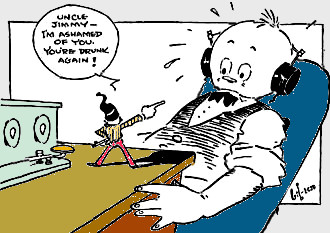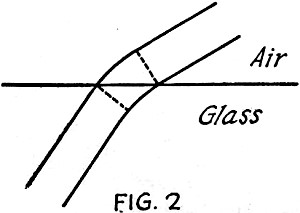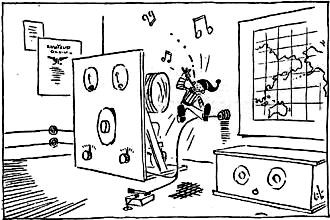The Pied Piper of Hamelin |
|
This might be my oldest copy of QST, being Vol. XIII, Number 6 (December 1915 was the first issue). Up until a few decades ago, authors commonly appropriated themes and characters from familiar fairy tales and fables for use in articles of instructional nature. Some publications even used comic book style formats for teaching to beginners. The term 'wabbulation' (aka "wobbulation" and "wobulation") is spoken to Uncle Jimmy by the fabled Piper, and I have to admit not being familiar with the term. According to W2PA's story, 1920s era QST technical editor Robert Kruse coined the word to describe inadvertent modulation of the carrier frequency during CW or phone operation. Per the Wikipedia entry, "wobulation is Hewlett-Packard's term for a form of interlacing designed for use with fixed pixel displays." This main theme of the Pied one is to disabuse Uncle Jimmy of opinions he held regarding capacitative [sic] reactance, atmospheric refraction, wave fronts, and other topics. The Pied Piper of Hamelin A "1929" Edition of an Old Story By Uncle Jimmy Dear, dear little Hams:
Well sir, it was a funny thing that happened to your old Uncle Jimmy. Maybe I went to sleep with the cans on - maybe not - but, anyway, I tuned in an honest-to-goodness fairy! It was a little fairy ham right from Hamelin Town. I knew right off that it was the Pied Piper, himself; I knew him by his sweet little d.c. note. It was that note, you know, that made all the little Hams follow him around like they did in the story-books. The Piper was a funny little fellow, not much taller than the receiver panel, and I couldn't help but laugh when he attempted to scowl at me. That little face wasn't meant for scowling. He stamped his little foot angrily and spoke: "Uncle Jimmy, I'm ashamed of you. You're drunk again!" Well, that sorta got me because I was sober as a judge and I never touched hard liquor anyway. I was just a little provoked. Now fairies are queer folks; they can read your thoughts like so much Continental. Piper gave me another hard look and went on: "Don't get uppish; you know what I mean. You're on a mental drunk. You have a lot of unorthodox ideas about radio an' I'm here to tell you you better get rid of 'em if you want to ever amount to anything! First thing you know, the Who's Who in radio will say' thumbs down' and you'll be out of a job -. "But wait! I can see by your thoughts that you're not in the radio business; you're just a ham and, as such, are entitled to all the crazy notions you like. Well, well; I'm sorry!" We shook hands merrily. Piper laughed till he wabbulated. "Gosh, that was a funny mistake," he said. "You know I read some of your stuff in QST and I thought I'd better come around and warn you that you were skating on the same sort of ice as was the preacher who wanted to hold dances in the church gymnasium." Piper's merry little eyes twinkled as he took a slip of paper out of his tiny pocket. "Since you're not one of the preachers, I can show you a cartoon I drew. It's called Fig. 1 and it's supposed to represent a horizontal Hertz. It's all out of shape so that a fellow can see its innards. The little dots represent free electrons that have been magnified a few billion times. "At A, the Hertz is supposed to have somehow received an electrical jolt which forced a lot of the free electrons to one end of the antenna. The electrons are all negative and they don't like being squeezed together because like things repel. The natural tendency of these electrons is to redistribute themselves evenly throughout the conductor. We call this tendency capacitative reactance. "Inductive reactance is like the country politician. It's 'agin' everything! It puts up a stiff fight at first and finally yields completely, being the reverse of capacitative reactance which resists but gently at first and finally brings the electronic procession to a complete halt. "The aim of capacitative reactance is to bring the electrons from the position of A to that of B and there to stop. Inductive reactance is 'agin' starting, but finally yields and, when the objective is reached, is 'agin' stopping, so that the procession travels on until again stopped as at C by capacitative reactance." Piper stopped and looked into my eyes mischievously. "See anything wrong with the picture so far?" he asked. "Why - uh - yes," I replied. "The textbooks always have dotted lines drawn between antenna and ground to show where the capacity comes in. You know you have to have both capacity and inductance to tune a cir -." "No, I don't know any such thing!" he broke in. "Of course, both capacity and inductance are going to be present in any circuit - tuned or otherwise - but let's just suppose that we can eliminate capacity entirely. The circuit will still be tuned because it will possess capacitative and inductive reactance - that's what counts. "The effect of capacity is shown at D. The crowded electrons in the left leg can see two ways of returning to a normal balance, but only one way is possible because of the insulating gap. The attraction across the gap serves to cause a little delay - reduces the frequency. "Here's a pair of fairy definitions: Capacitative reactance is the tendency of the free electrons in a conductor to preserve a state of electrical equilibrium, and capacity is simply a means of reducing capacitative reactance. "The first definition is really too narrow because capacitative reactance actually tends to keep all matter in a state of electrical balance - just as gravity tends to keep water in a state of mechanical balance. Since 'all matter' includes nonconductors as well as conductors, a fellow can see how electrical waves can exist in a dielectric - such as air. Of course, actual current-flow can only take place in a conductor where there are free electrons that can skip from atom to atom, but displacement 'currents' can 'flow' quite readily in a dielectric. The idea is that the electrons belonging to an atom, being disturbed, swing out in the electrical breeze and transmit the disturbance to adjacent atoms which, in turn, jar their neighbors and so on and on. Not an electron leaves its atom, but the impulse travels like actual current-flow and is subject to inductive and capacitative reactance." "Yes," I interrupted, "it's not hard to see how radio waves travel through dielectrics, but how do they cross interstellar space? "The men of science drag in the ether theory. Ether is something which is supposed to be nothing and pervades all space. If it pervades space, where is the space? Or, if it is nothing why talk about it?" Piper changed to an apparently irrelevant subject. "Say, Uncle Jimmy, I'm going to tell you how to secure a perfect vacuum in a 'vacuum' tube. Construct a very tall tube - if it isn't tall enough, make it taller - put all three electrodes in the very top of the thing and pump as much air as you can from the bottom. Gravity will now cause the residual air to settle (?) to the bottom, leaving a perfect vacuum at the top! "Oh! Gasses like to disperse, do they? Then consider this: Some gasses weigh so little that a balloon filled with them will lift almost as much weight as the weight of the air it displaces. Suppose we release a quantity of such very light gas. It will rise to the upper limit of the atmosphere - if there is a limit. The farther the gas recedes from the earth the less it will weigh because the gravitational attraction will be lessened by the distance. As it recedes from the earth, the surrounding atmosphere will be less dense and exert less pressure on it. It will, therefore, expand in its effort to fill all the available space. Which will win, the attraction of gravity, or the tendency of gasses to fill every nook and cranny of 'space'? Suit yourself, but don't forget that the very same scientists who claim that interstellar space is a void, insist that 'nature abhors a vacuum!' Yes, 'space' is filled with atmosphere; it's darn thin, but it's there." Uncle Jimmy wants you little Hams to remember that he is just telling you what Piper said. I'm not saying that it's true. Don't try to tell it to big brother, R. E. Ham, because he won't believe it. He doesn't believe in fairies. "Let's talk some more about wave propagation," suggested Piper. "I can see that you're kinda dumb about such things." He fished another piece of paper out of his tiny pocket before I could decide whether or not to get mad. "This is Fig. 2," he said. "It shows how light waves get bent when they pass at an angle from a dense to a thin or a thin to a dense medium. I drew double lines to show that the light beam has dimensions. Now, Uncle Jimmy, do you know why the wave changes its direction of travel?"
Fig. 2 - Refraction at glass-air interface "I don't remember of anyone ever telling me why." "No," said Piper, "they usually don't try to tell that part of the story. Well, here's why: Light travels faster in a thin medium than it does in a dense one - faster in air than in glass, for example." "But the velocity of light is constant!" I protested. "You're wrecking the relationship between wavelength and frequency!" "Wavelength my eye!" snorted Piper. "That's out. Shut up; and don't interrupt me again." (Fairies are so short tempered!) "Look at the picture and you will see that there is an instant when one side of the beam is in one medium and the other side is in the other. During this instant, one side of the wave travels faster than the other. Naturally, it turns. "Even a slight difference in the density of the mediums will cause refraction of light, as you can prove by noting the distorted appearance of the objects viewed over the top of a hot radiator or stove. The density of our atmosphere decreases with increase in altitude. This difference in density refracts light waves a little. It refracts radio waves to a greater extent because the dimensions of the radio wave are greater than the light wave and one side of the radio wave is in a medium much denser than is the other. "Oh, sure; the Kennelly-Heaviside layer is there, all right, but I wanted to point out that it isn't the only thing that affects the direction of radio waves, If it were, the Warner Splatter System wouldn't work. "Well, Uncle Jimmy, I'll have to say '73' and 'CUL' because the rat business is pretty heavy of late and it doesn't leave me much time for DX. I worked Jupiter last night with three ergs input to my pipe."
Now, dear little Hams, Uncle Jimmy has told you a nice bed-time story - a fairy tale - and he has told it for a reason. It is quite probable that everything I have said is all nonsense. There is the possibility, though, that some of it is on a par with Mr. Warner's famous Splatter System, some of it may be right. (No, no Officer! Mr. Warner is entitled to the first ride in the nice wagon!) The purpose of the fairy tale is to point out that there are no flanges on the imaginative wheels of a mere Ham. He isn't hampered by the knowledge of So-and-so's Law and of such-and-such an equation that must be satisfied. He can't see the hundred-and-one reasons why his theory must be wrong. The marvelous part of it is that the ham is sometimes right. A boy once said: "I have a kite. It is heavier than air, yet it flies. Someday I will fly like that!" Learned engineers pointed out to the boy that the scheme was impossible. Their argument ran something like this: If the weight of the kite is doubled, twice as much surface will be needed to support it, but if one starts by doubling the surface, he will find that he has increased the weight about four times in order to keep the same proportion of structural strength. A kite, they said, with enough surface to support the weight of a man would be too heavy to lift itself! The engineers deserved to be right. They had given the problem deeper study than had the boy. They were hampered, though, by their own knowledge! We all know that the boy was right. We can depend upon scientists and engineers to develop new territory to the limit after we have discovered it, but the burden of discovery rests upon our shoulders. An eminent engineer cannot risk his reputation by talking about fairies until he has positive proof that fairies exist. I can. You can. We have nothing to lose by being wrong and have everything to gain if we should happen to be right. Another thing: I know some fellows who have a lot of original "kinks" in their shacks. These fellows don't mean to be stingy with their ideas; they are merely afraid to send them in for fear QST will turn them down. Gosh! I wish QST would turn down my stuff. Whenever that happens, I will know that the editors have been able to fill QST with material better than mine. That won't be bad luck for anyone! The best of whatever comes in is printed in QST; if that "best" is sometimes 'pretty poor, it's our fault - your fault!
Do you trunk that a fellow fully pays his way to a convention when he planks down the price of the banquet? He doesn't. The fellow who goes to a convention with the idea of absorbing all the valuable information he can without giving a thing in return from his own store of knowledge isn't quite honest! You may get a copy of QST for a quarter - but you can't pay for it in that way. Let's be honest. There isn't room for all of us to push; some must ride, but we can only discover the best pushers (many of whom are still hidden lights) by everyone trying to push. I am not trying to set myself up as a shining, unselfish example; this is really written for a selfish reason. It's like this: QST is priced at two-bits per copy. I feel that I am only getting about thirty-five cents worth out of it. I am beset with a hunch that we can raise the value (not the price) to four-bits. In other words, I want to double my money on a sure thing! All this sounds fine, but I have lived long enough to find out that we very seldom, if ever, get something for nothing. I have learned that the statement, "Honesty is the best policy," is a truth. Please note that the statement has nothing to do with morals. Emphasize the word, policy. The more willing we are to pay, the more likely we are to get our money's worth. The fellow who thinks he is going to escape payment often pays most heavily in the end. The two-bits we pay for QST couldn't begin to cover the cost of publishing it, but because the advertisers are willing to pay, it isn't a losing proposition. The advertisers are business men - not moralists - yet they are willing to pay. Why? Because they know that they can't get something for nothing. They want increased sales and they know they will have to pay for it. We, in turn, pay the advertisers. The more we pay them, the more they will advertise. We win. They win. Piper grasped the antenna and vaulted lightly into space QST would be on a par with any other two-bit magazine if we only put into it two-bits plus what we pay the advertiser. Here we put our finger on beautiful opportunity. It is the privilege of the members of the A.R.R.L. to raise the value of QST to whatever they like by increasing the value of their contributions. Here, again, the fellow who is most willing to pay reaps the most benefit. A fellow cannot write an article for QST without automatically learning more than he does in reading a whole issue - full of the other fellow's stuff. If, for instance, Mr. Warner is wearing a grouch because he cannot find two men to take the place of Ross Hull and turns this yarn down in consequence (articles are always turned down because the editor has a grouch) I, at least, will still be the winner because of what I have been forced to learn in writing it. My dear little Hams, if you don't like to listen to Uncle Jimmy's fairy tales, don't just tune me out - that would be wasteful - but put me off the air. The way to do that is to get into the uncle business yourselves and out-uncle me. Then everyone will profit, including Uncle Jimmy. 73, little Hams, and sleep tight; the boogers at Washington can't get you if you mind what Mamma and Papa Ham tell you. Nighty-night! Exit Uncle Jimmy. Cries are heard from without: "Please, Officer! Get a bigger wagon; I had to stand all the way last time!"
Posted July 20, 2020 |
|





